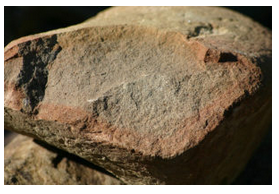4.2.5: Weathering and Diagenesis
- Page ID
- 19136

Weathering is the breaking down or decomposition of rocks and minerals because of reactions with the atmosphere or water, and sometimes biological organisms. The process occurs in place at or near Earth’s surface, and is distinct from erosion, which involves transportation of material by water, wind, gravity and other agents. During weathering, large rocks or mineral grains typically break apart. Simultaneously, new minerals may form from old ones. Iron oxides, quartz and clay often dominate highly weathered material. These minerals formed as other minerals disappeared. The photo shows a boulder with a distinct red layer of iron oxide on its outside that formed by weathering.
Diagenesis can occur after weathering has taken place, especially after a sediment is deeply buried. It involves physical and chemical changes in sediments that occur as the sediments are lithified and turn into a sedimentary rock. Diagenesis commonly leads to minerals disappearing and being replaced by others through processes involving both weathering and low-temperature metamorphism. Thus, no sharp boundary exists between diagenesis and metamorphism, although many geologists choose an arbitrary burial temperature of 200 oC as the beginning of metamorphism. Agents of diagenesis include pressure and heat caused by burial. Often, hydrothermal solutions are involved as well.
Chapter 7 includes a more detailed discussion of weathering and diagenesis.


